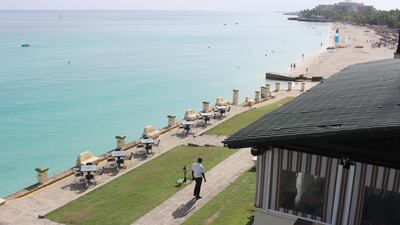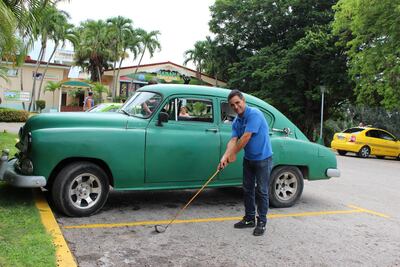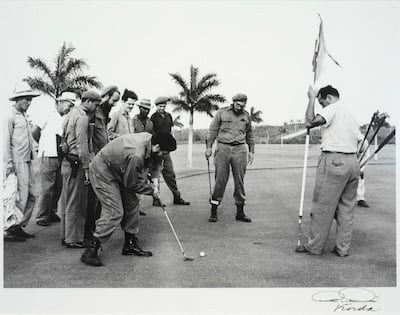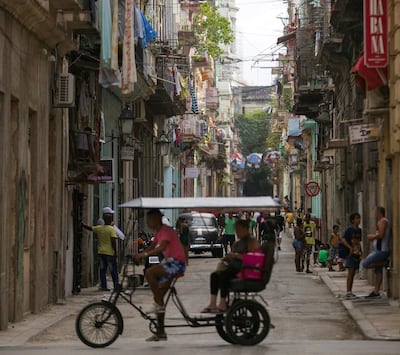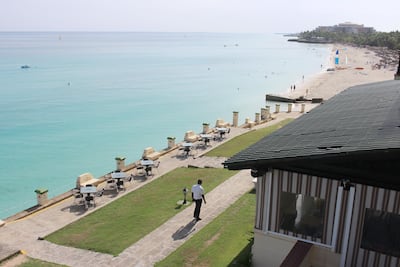A starting time is hard to come by at Guantanamo Bay. I couldn't even pay to get in and form a one-man gallery to watch the four-ball competition between Camp Echo and Camp Delta.
Lateral Hazard Golf Club is more exclusive than Muirfield, Pebble Beach, Old Head and Augusta National combined. You don’t walk on to the Gitmo golf course on the south-east coast of Cuba. You have to be deployed there. Or posted to it.
Although it has restaurants, a skate park, bowling alley, open-air cinema, Iggy's Cafe, O'Kelly's Bar, a nature trail, baseball batting cages, three swimming pools and a gym, the nine-hole par 30 US Naval Station Yatera Seca golf course, just north of Whitney Field's West Gate, with its two trees, and "minimal elevations and undulations", will never host the Ryder Cup or US Open. Only American joint services personnel, members of the Joint Task Force and Department of Defence civilians can play it. And pick up their scorecards from the camp's Liberty Centre clubhouse.
A symbol of capitalist decadence
For a long time, golf was banned in Cuba for being too elitist. It was considered bourgeois. A game for the idle rich. Not the people. Not the proles. It was loathed by the socialist revolutionaries as a symbol of social exclusion. Fidel Castro preferred baseball and had his own team, Los Barbudos, or the Bearded Ones. His only golf quote was: “I know absolutely nothing about this expensive sport.” This soon became obvious.
A month before the Bay of Pigs in 1961, photographer Alberto Korda famously captured Castro and Ernesto "Che" Guevara playing golf at Colinas de Villareal, which was subsequently dug up and turned into barracks. Castro wasn't one for tailored collars or spikes, preferring jackboots, a beret or an olive green bring-military-to-the-masses corps hat and hospital laundry uniform passing as combat fatigues. Their caddies wore holstered pistols.
Castro's stance never changed. He hated golf and what it stood for – capitalist decadence. He putted left-handed and, using what is a traditional interlocking, knuckle-up-the-barrel baseball grip, drove right-handed. He favoured a cigar to line up and "feel" putts. In one of the photographs, Guevara also employs a rather unorthodox claw grip.
Guevara liked his golf – he had caddied in Argentina. On a wall in the lobby of Cuba’s five-star all-inclusive Hotel Melia Las Americas in Varadero are photographs of the golfing greats – Bobby Jones, Walter Hagen, Ben Hogan, Tom Watson, Lee Trevino – and Guevara. The world’s most famous guerrilla suffered from asthma as a child and his father got him to carry his clubs to get some fresh air.
Guevara beat Castro in their golf match, a propaganda exercise mocking Kennedy. Castro shot 157. Sulkily, he banished the game from Cuba. Ploughing up golf courses was part of his utopian dream of social progress. His son, Antonio, on the other hand, is now a keen golfer, and has even won a tournament on the island.
Reviving the sport
Cuba has one of the highest adult literacy rates in the world. It has more doctors per capita than anywhere else on the planet. But the largest island in the Caribbean has just two golf courses and, out of a population of 11 million, only 40 registered golfers. And two pros.
Nonetheless, a golf revolution is under way in a country where one green fee can be the equivalent of three months’ wages. The sport is spearheading the country’s renewed tourism drive, with several new golf resorts in the pipeline to join the two currently in existence.
The nine-hole Donald Ross-designed Havana Golf Club, or Rovers Athletic Club, was founded by the English in 1911. Moving to the Airport Road in 1953, it somehow survived the 1959 revolution. It is still an up-and-down diplomats' course, with tatty red rags on bamboo poles and yardages painted on tree trunks. There are 35 members and 20 regular players – all foreign, mostly embassy officials – and 18 holes cost Dh188. Pro Johan Vega gives lessons, but no one really wants them. The club has hosted professional tournaments and attracted big names like Sam Snead, Gene Sarazen, Billy Casper and Arnold Palmer, and it still holds an annual Commonwealth and Canada Cup.
The close link between Cuban golf and Canada is revealed on the greens at Varadero Golf Club, two hours from Havana. The golf markers have the Canadian flag on one side and the Cuban on the other. All the Taylor Made rental clubs and golf buggies come from Canada. Green fees are Dh367.
The course is attached to the all-inclusive Melia Las Americas Hotel, and its golf specialist Reynaldo Leon Diaz trained in British Columbia. “We have regular showcase tournaments, like the Melia Las Americas Cup in May, Varadero Golf Tournament in September and Grand Tournament in October. We set up the first golf academy in Cuba.
“The thing I like most is driving a golf buggy. In Cuba we don’t all drive around in flash 1950s Yank tanks. Most of us walk. Or get the bus,” Reynaldo says.
A round at Varadero
Pro Pedro Klein’s favourite hole at the Varadero is the par 3 eighth, with the beach and Gulf of Mexico down the left. It is called Paradise. Other good holes are the fourth, Iguana, the par 3 sixth, Nice Dream, the fifteenth, Devil’s Smile and the last, The Watchman, which is named after the stone Mayan God of Life statue, and is a 150-yard pull off the tee, with pink seashell markers.
Xanadu is the place to stay. Not Citizen Kane's legendary 49,000-acre Xanadu, or Hearst Castle, San Simeon, California, which inspired it. Not Bill Gates's Xanadu 2.0 home overlooking Lake Washington in Medina, but Irénée du Pont's "stately pleasure dome" on the Gulf of Mexico in Varadero, Matanza, Cuba.

This property is currently undergoing an extensive makeover. The 1927, four-storey, eight-bedroom beachfront Xanadu Mansion was built by the French-American chemical magnate, who retired to Cuba, buying himself 180 hectares of the Hicacos Peninsula, including eight kilometres of beach, which cost over a million dollars to build. The gardens were planted with coconut, banana, avocado and papaya trees, and parrots and cockatoos were imported to make it "more tropically enchanting".
Du Pont also installed the largest privately owned organ in all of Latin America. The $11,000 instrument is still in the basement, but is no longer operational. It used to work automatically and manually, with two shafts carrying the music to the balcony and lobby, calling guests to dinner. Precious dark hardwoods were brought from Santiago de Cuba for Xanadu’s ceilings, stair rails and columns, and floors and bathrooms were done up in Cuban, Italian and Spanish marble.
For Dh955 a night, half board, you can stay in the six exotically named second-floor rooms – Califa, Oasis, Irenee, Samarkanda, Marco Polo and Kubla Khan. The restaurant menu offers lobster du Pont-style (warm Caribbean lobster salad with soja) and Canadian/Uruguayan chateaubriand. Chef Lima's signature desserts are chocolate fondant and apple pie, and Xanadu has its own extensive cigar menu. A Cohiba Behike 54 costs Dh152, but you'll have to smoke it outside.
No handicap certificate is required on Varadero’s golf course, Cuba’s only 18-holer. The 1998 course – 6,865 yards off the “Oro” or gold, and backed with shoreline holes and seawater lagoons, was designed by Canadian Les Furber, protégé of Robert Trent Jones senior.
Cuba hopes to be a major golf destination within 30 years – and it all begins at Xanadu. In 1933, a hurricane swept away five holes outside the front door. More than $10,000 worth of soil was needed to reopen the course in 1936. At the time, the green fee was a buck – half went to the caddie and the rest to a local school. In 1963, on the day du Pont died at the age of 85, Xanadu’s Las Americas Restaurant was officially opened by Russian astronaut Valentina Tereshkova.
Only in Cuba.
